Study on the Microstructure and Mechanical Properties of Ultrasonic-Assisted TIG Welded 441 Ferritic Stainless Steel Joints
Abstract
:1. Introduction
2. Experimental
2.1. Materials and Test Methods
2.2. Ultrasonic-Assisted Tungsten Argon Arc Welding Process
3. Results and Discussion
3.1. Microstructure of Welded Joint Prepared via Ultrasonic-Assisted Welding
3.2. Mechanical Properties of Welded Joint under Ultrasonic-Assisted Welding
3.3. Grain Refinement of Ultrasonic-Assisted Welding
4. Conclusions
Author Contributions
Funding
Data Availability Statement
Conflicts of Interest
References
- Zhang, Z.; Han, Y.; Lu, X.; Zhang, T.; Bai, Y.; Ma, Q. Effects of N2 content in shielding gas on microstructure and toughness of cold metal transfer and pulse hybrid welded joint for duplex stainless steel. Mater. Sci. Eng. A 2023, 872, 144936. [Google Scholar] [CrossRef]
- Maurya, A.K.; Chhibber, R.; Pandey, C. Heat Input Effect on Dissimilar Super Duplex Stainless Steel (UNS S32750) and Nitronic Steel (N50) Gas Tungsten Arc Weld: Mechanism, Microstructure, and Mechanical Properties. J. Mater. Eng. Perform. 2023, 32, 5283–5316. [Google Scholar] [CrossRef]
- Mounarik Das, M.; Ahn, H.; Hong, E.Y.; Kim, S.T.; Han, M.-J.; Pal, H.N.; Kumar, T. Characterization of friction stir welded joint of low nickel austenitic stainless steel and modified ferritic stainless steel. Met. Mater. Int. 2017, 23, 948–957. [Google Scholar]
- Okayasu, M.; Shigeoka, T. Effect of Microstructural Characteristics on Mechanical Properties of Ferritic Stainless Steel. J. Mater. Eng. Perform. 2019, 28, 6771–6778. [Google Scholar] [CrossRef]
- Dong, Z.; Li, Y.; Lee, B.; Babkin, A.; Chang, Y. Research status of welding technology of ferritic stainless steel. Int. J. Adv. Manuf. Technol. 2020, 118, 2805–2831. [Google Scholar] [CrossRef]
- Chen, C.; Shang, C.J.; Weng, J.; Li, D.Y. Corrosion Behavior of a New Developed Ferritic Stainless Steels Used in Automobile Exhaust System. Adv. Mater. Res. 2010, 89–91, 102–106. [Google Scholar] [CrossRef]
- Sato, E.; Tanoue, T. Present and future trends of materials for automotive exhaust system. Nippon Steel Tech. Rep. 1995, 64, 13–19. [Google Scholar]
- Amuda, M.; Mridha, S. Grain refinement and hardness distribution in cryogenically cooled ferritic stainless steel welds. Mater. Des. 2013, 47, 365–371. [Google Scholar] [CrossRef]
- Taban, E.; Kaluc, E.; Dhooge, A. Hybrid (plasma+gas tungsten arc) weldability of modified 12% Cr ferritic stainless steel. Mater. Des. 2009, 30, 4236–4242. [Google Scholar] [CrossRef]
- Lakshminarayanan, A.; Balasubramanian, V. An assessment of microstructure, hardness, tensile and impact strength of friction stir welded ferritic stainless steel joints. Mater. Des. 2010, 31, 4592–4600. [Google Scholar] [CrossRef]
- Ahn, B.W.; Choi, D.H.; Kim, D.J.; Jung, S.B. Microstructures and properties of friction stir welded 409L stainless steel using a Si3N4 tool. Mater. Sci. Eng. A Struct. Mater. Prop. Microstruct. Process. 2012, 532, 476–479. [Google Scholar] [CrossRef]
- Villaret, V.; Deschaux-Beaume, F.; Bordreuil, C.; Fras, G.; Chovet, C.; Petit, B.; Faivre, L. Characterization of Gas Metal Arc Welding welds obtained with new high Cr–Mo ferritic stainless steel filler wires. Mater. Des. 2013, 51, 474–483. [Google Scholar] [CrossRef]
- Swati, J.; Nilesh, D.; Rajeev, A. A study on the effect of welding on HAZ, mechanical properties and corrosion of AISI 409m ferritic stainless steel by SMAW, TIG and MIG welding. Int. J. New Innov. Sci. Technol. 2015, 3, 1–9. [Google Scholar]
- Sánchez-Cruz, T.d.N.; Curiel-López, F.; López-Morelos, V.; González–Sánchez, J.; Ruiz, A.; Carrillo, E. Optimization of macro and microstructural characteristics of 316L/2205 dissimilar welds obtained by the GMAW-pulsed process. Mater. Today Commun. 2023, 34, 105401. [Google Scholar] [CrossRef]
- Mohandas, T.; Reddy, G.M.; Naveed, M. A comparative evaluation of gas tungsten and shielded metal arc welds of a “ferritic” stainless steel. J. Am. Acad. Dermatol. 1999, 94, 133–140. [Google Scholar] [CrossRef]
- Wang, Y.; Ding, M.; Zheng, Y.; Liu, S.; Wang, W.; Zhang, Z. Finite-Element Thermal Analysis and Grain Growth Behavior of HAZ on Argon Tungsten-Arc Welding of 443 Stainless Steel. Metals 2016, 6, 77. [Google Scholar] [CrossRef]
- Oh, D.; Han, K.; Hong, S.; Lee, C. Effects of alloying elements on the thermal fatigue properties of the 15wt% Cr ferritic stainless steel weld HAZ. Mater. Sci. Eng. A Struct. Mater. Prop. Microstruct. Process. 2012, 555, 44–51. [Google Scholar] [CrossRef]
- Lan, H.-X.; Gong, X.-F.; Zhang, S.-F.; Wang, L.; Wang, B.; Nie, L.-P. Ultrasonic vibration assisted tungsten inert gas welding of dissimilar metals 316L and L415. Int. J. Miner. Met. Mater. 2020, 27, 943–953. [Google Scholar] [CrossRef]
- Chen, C.; Fan, C.; Liu, Z.; Cai, X.; Lin, S.; Zhuo, Y. Microstructure Evolutions and Properties of Al–Cu Alloy Joint in the Pulsed Power Ultrasonic-Assisted GMAW. Acta Met. Sin. (Engl. Lett.) 2020, 33, 1397–1406. [Google Scholar] [CrossRef]
- Li, F.; Chen, F.; Gao, P.; Wang, W.; Yang, C.; Liu, S. Effect of Ultrasonic Power on the Microstructure and Properties of 304 Stainless Steel Welded Joints Through Cold Metal Transfer Welding Assisted with Ultrasonication. Met. Mater. Int. 2023, 29, 3039–3051. [Google Scholar] [CrossRef]
- Morisada, Y.; Fujii, H.; Inagaki, F.; Kamai, M. Development of high frequency tungsten inert gas welding method. Mater. Des. 2013, 44, 12–16. [Google Scholar] [CrossRef]
- Wang, Y.; Cong, B.; Qi, B.; Yang, M.; Lin, S. Process characteristics and properties of AA2219 aluminum alloy welded by double pulsed VPTIG welding. J. Am. Acad. Dermatol. 2019, 266, 255–263. [Google Scholar] [CrossRef] [PubMed]
- Wang, Y.; Qi, B.; Cong, B.; Zhu, M.; Lin, S. Keyhole welding of AA2219 aluminum alloy with double-pulsed variable polarity gas tungsten arc welding. J. Manuf. Process. 2018, 34, 179–186. [Google Scholar] [CrossRef]
- Wang, D.; Wu, C.; Suo, Y.; Wang, L.; Liang, Z. Effect of pulse frequency on arc behavior and droplet transfer of 2198 Al-Li alloy by ultra-high-frequency pulse AC CMT welding. J. Mater. Res. Technol. 2019, 8, 3950–3958. [Google Scholar] [CrossRef]
- Qi, B.J.; Yang, M.X.; Cong, B.Q.; Liu, F.J. The effect of arc behavior on weld geometry by high-frequency pulse GTAW process with 0Cr18Ni9Ti stainless steel. Int. J. Adv. Manuf. Technol. 2013, 66, 1545–1553. [Google Scholar] [CrossRef]
- Wu, K.; Yuan, X.; Li, T.; Wang, H.; Xu, C.; Luo, J. Effect of ultrasonic vibration on TIG welding–brazing joining of aluminum alloy to stee. J. Mater. Process. Technol. 2019, 266, 230–238. [Google Scholar] [CrossRef]
- Dai, W.-L. Effects of high-intensity ultrasonic-wave emission on the weldability of aluminum alloy 7075-T6. Mater. Lett. 2003, 57, 2447–2454. [Google Scholar] [CrossRef]
- Chen, C.; Fan, C.; Cai, X.; Lin, S.; Yang, C.; Zhuo, Y. Microstructure and mechanical properties of Q235 steel welded joint in pulsed and un-pulsed ultrasonic assisted gas tungsten arc welding. J. Mater. Process. Technol. 2020, 275, 116335. [Google Scholar] [CrossRef]
- Sun, Q.J.; Lin, S.B.; Yang, C.L.; Zhao, G.Q. Penetration increase of AISI 304 using ultrasonic assisted tungsten inert gas welding. Sci. Technol. Weld. Join. 2009, 14, 765–767. [Google Scholar] [CrossRef]
- Xie, J.; Chen, Y.; Yin, L.; Zhang, T.; Wang, S.; Wang, L. Microstructure and mechanical properties of ultrasonic spot welding TiNi/Ti6Al4V dissimilar materials using pure Al coating. J. Manuf. Process. 2021, 64, 473–480. [Google Scholar] [CrossRef]
- Watanabe, T.; Shiroki, M.; Yanagisawa, A.; Sasaki, T. Improvement of mechanical properties of ferritic stainless steel weld metal by ultrasonic vibration. J. Mater. Process. Technol. 2010, 210, 1646–1651. [Google Scholar] [CrossRef]
- GB/T 228; Metallic Materials—Tensile Testing. Standardization Administration of China: Beijing, China, 2010.
- Jamshidi, R.; Brenner, G. Dissipation of ultrasonic wave propagation in bubbly liquids considering the effect of compressibility to the first order of acoustical Mach number. Ultrasonics 2013, 53, 842–848. [Google Scholar] [CrossRef]
- Zhang, Y.N.; Wang, L.; Morioka, S.; Wang, W.M. Modified Lennard-Jones potentials for Cu and Ag based on the dense gaslike model of viscosity for liquid metals. Phys. Rev. B 2007, 75, 014106. [Google Scholar] [CrossRef]
- Ma, L.; Shu, G.; Feng, C. Research on Solidification of Metal Melt under Ultrasonic Field. Mater. Sci. Eng. 1995, 13, 2–7. [Google Scholar]
- Ashiri, R.; Niroumand, B.; Karimzadeh, F. Physical, Mechanical and dry sliding wear properties of an Al-Si-Mg-Ni-Cu alloy under different processing conditions. J. Alloys Compd. 2014, 582, 213–222. [Google Scholar] [CrossRef]
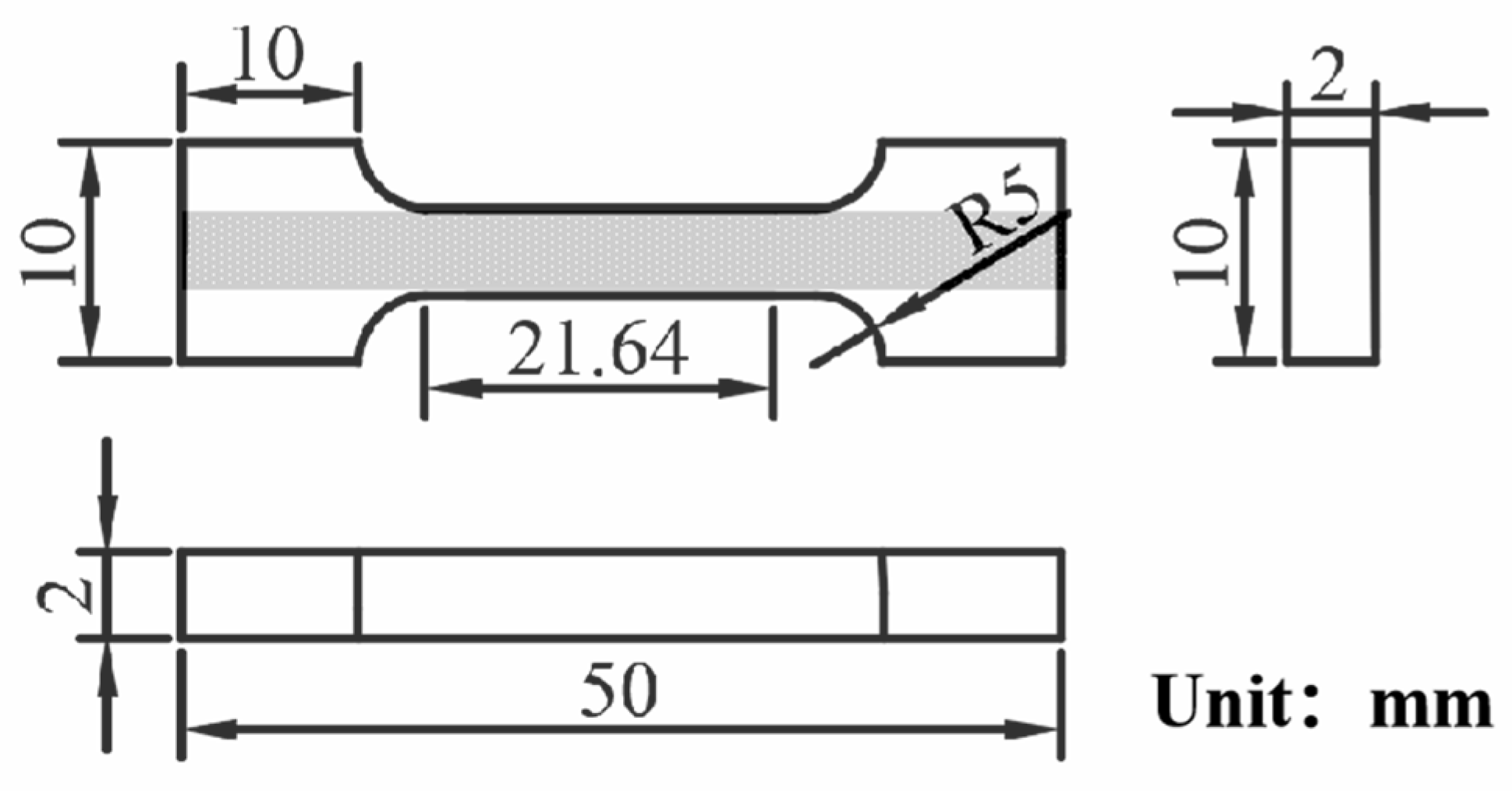
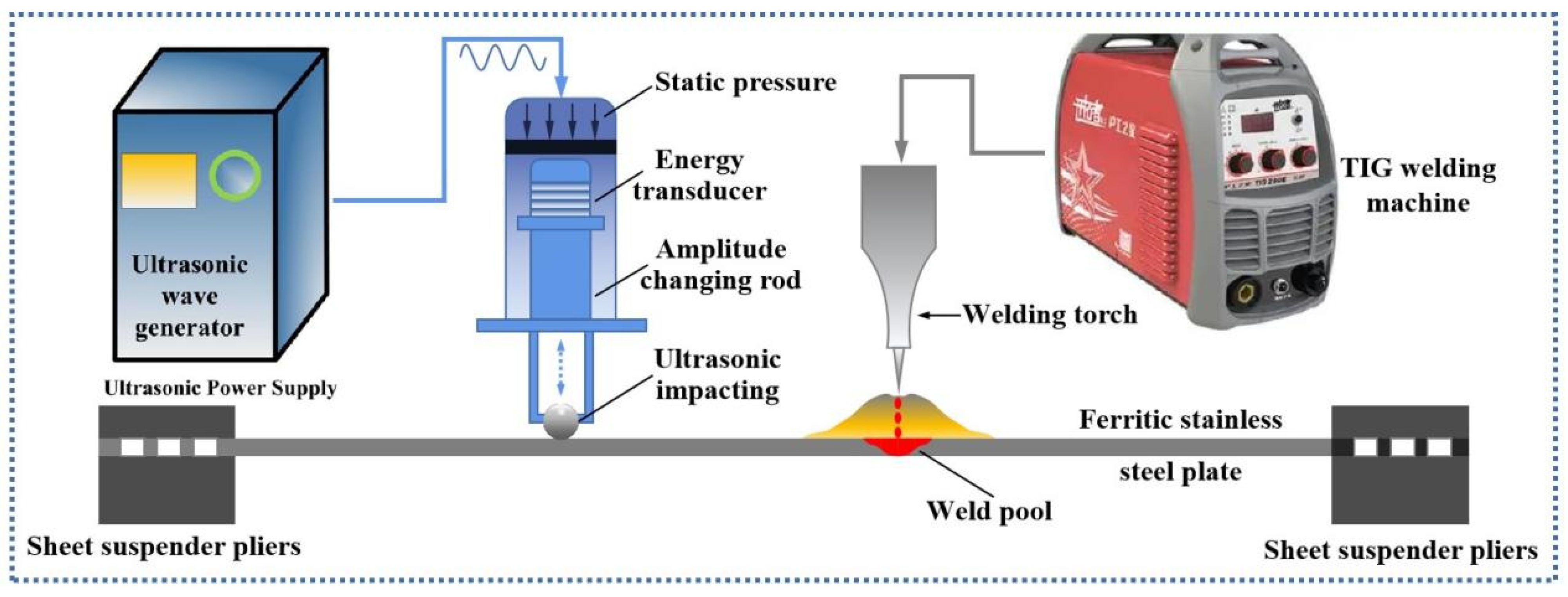
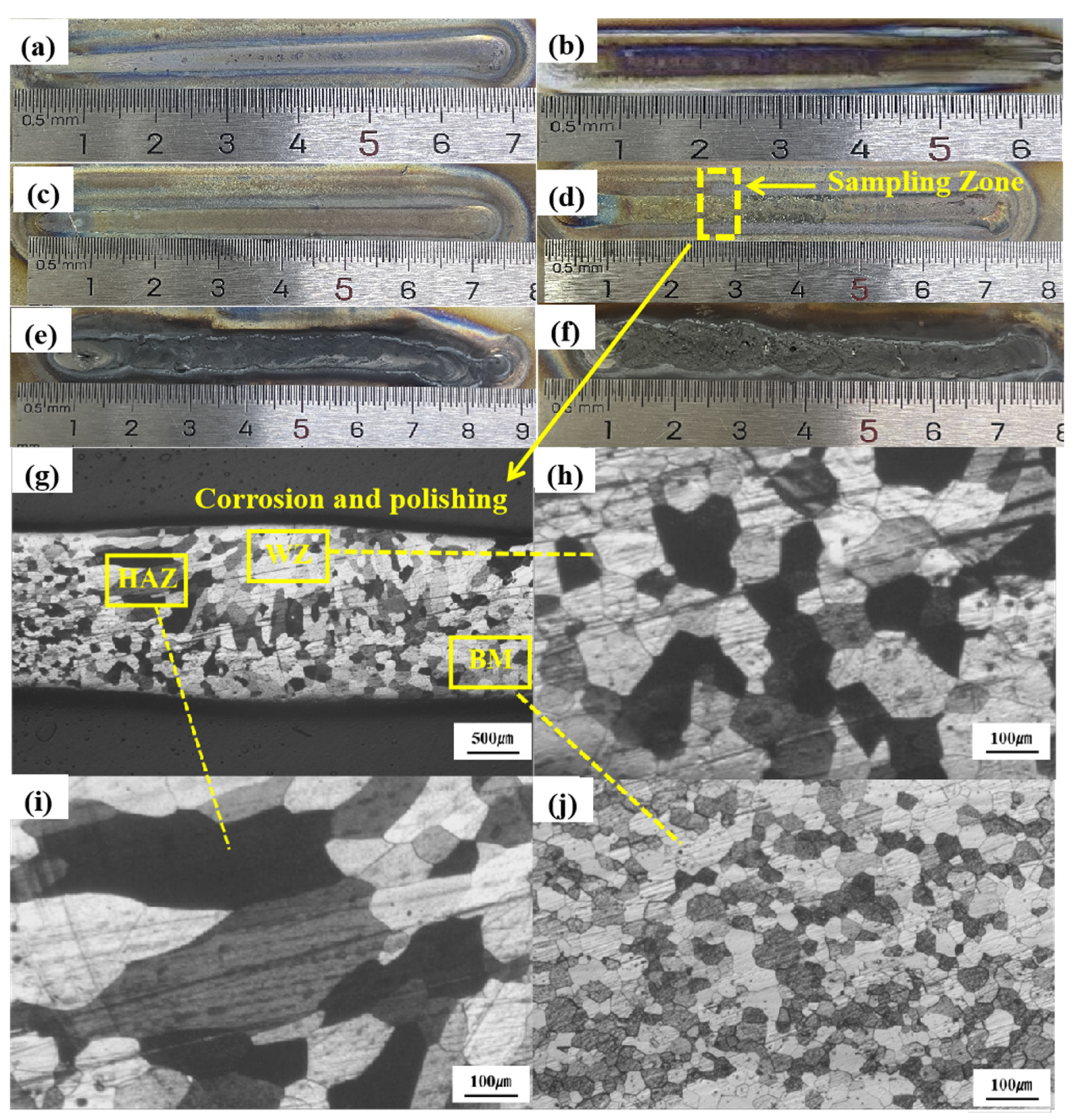
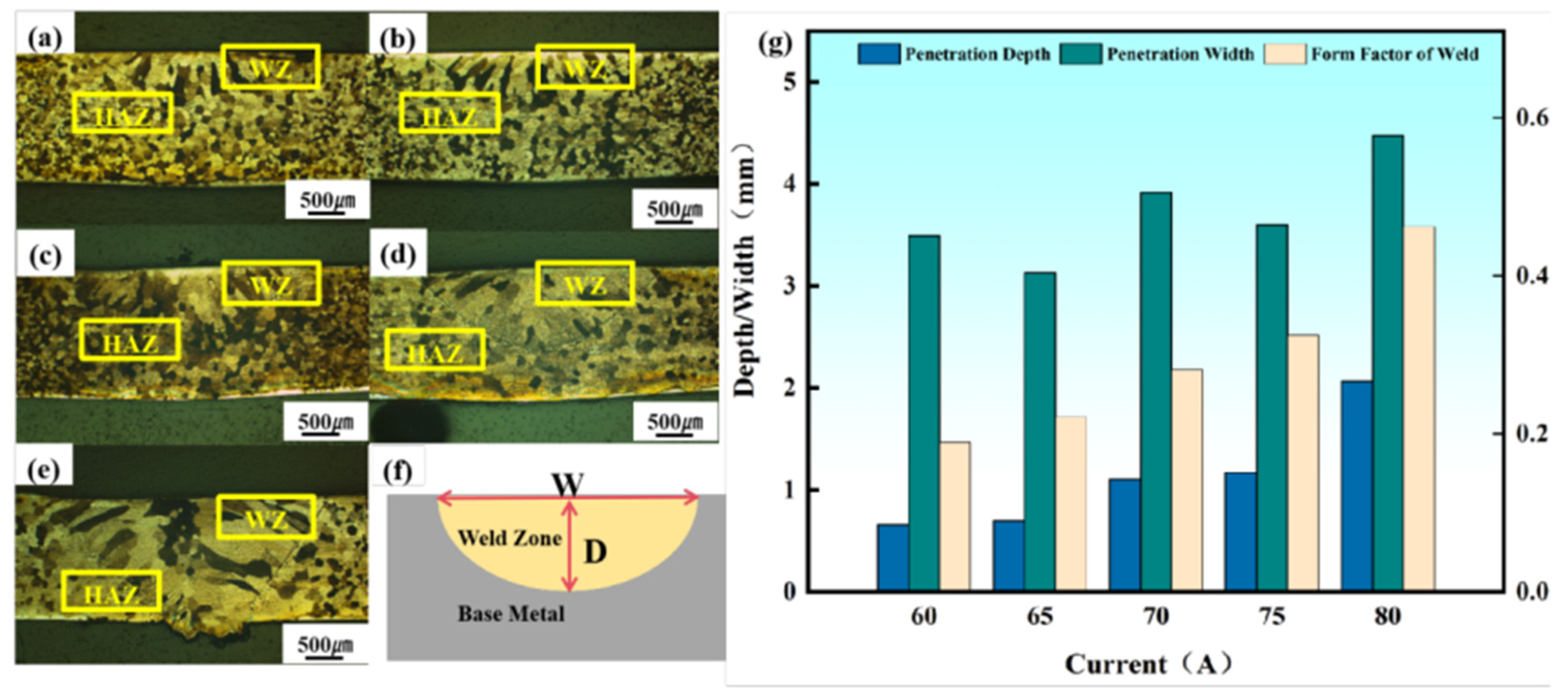
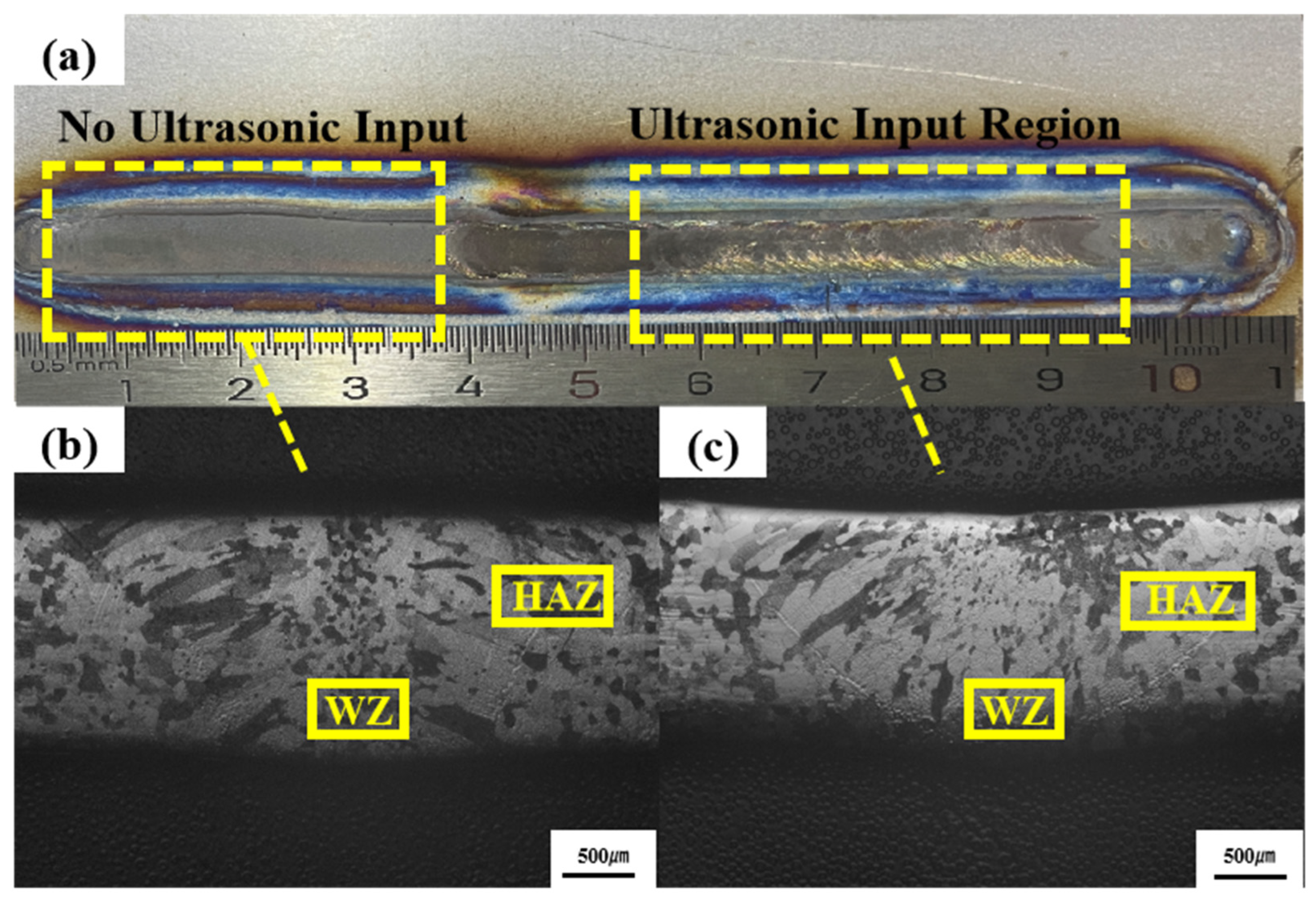
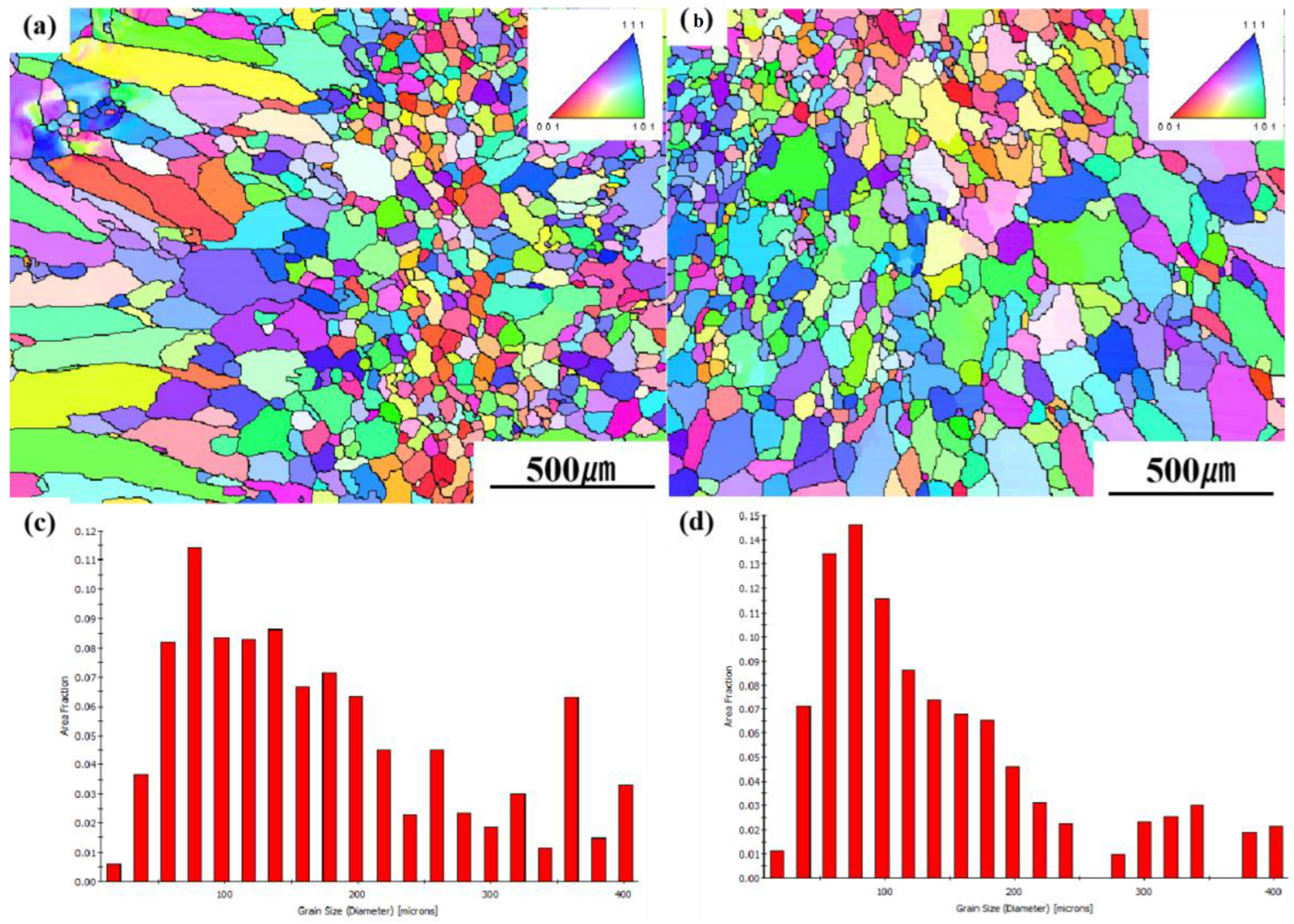
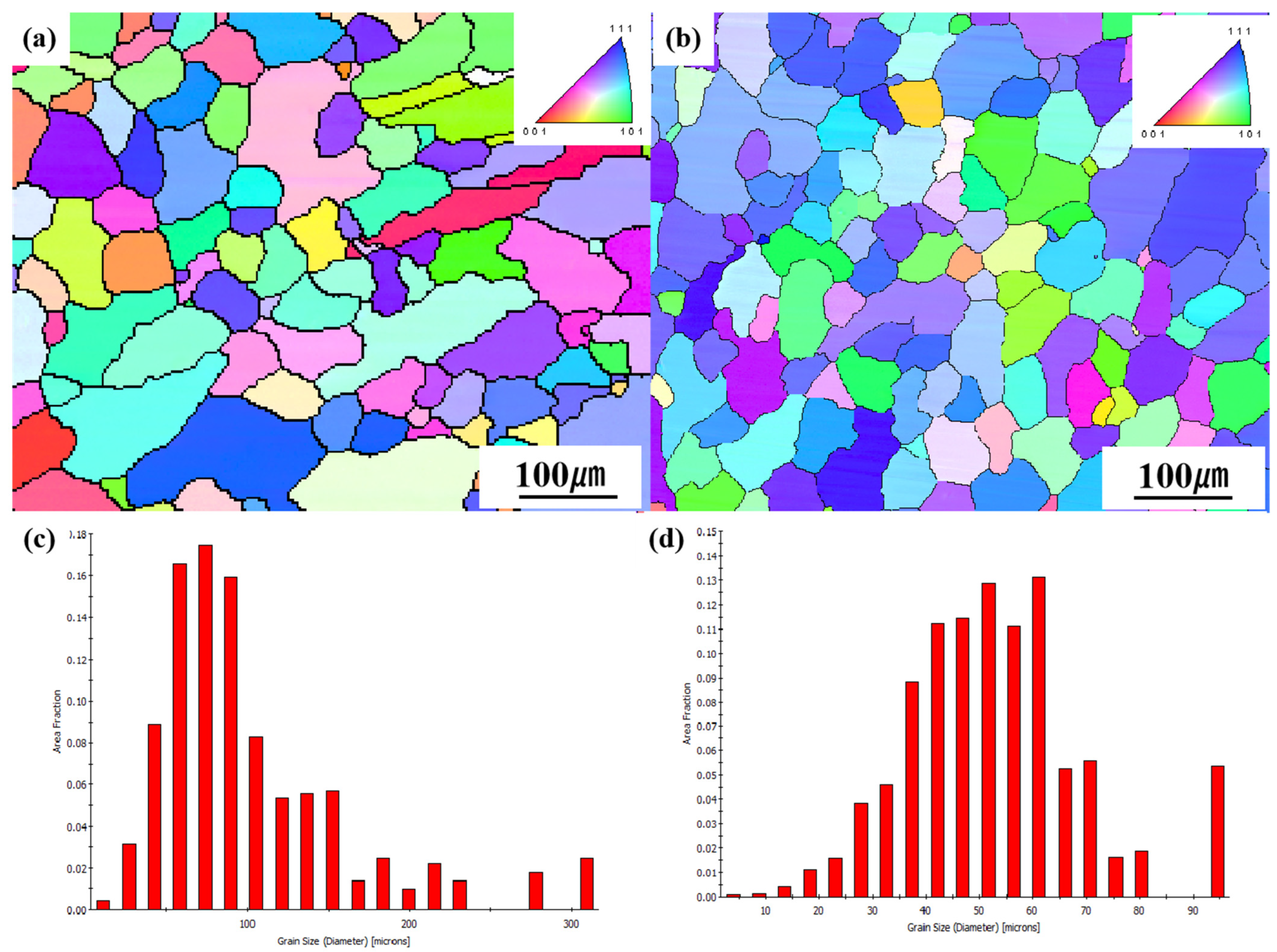
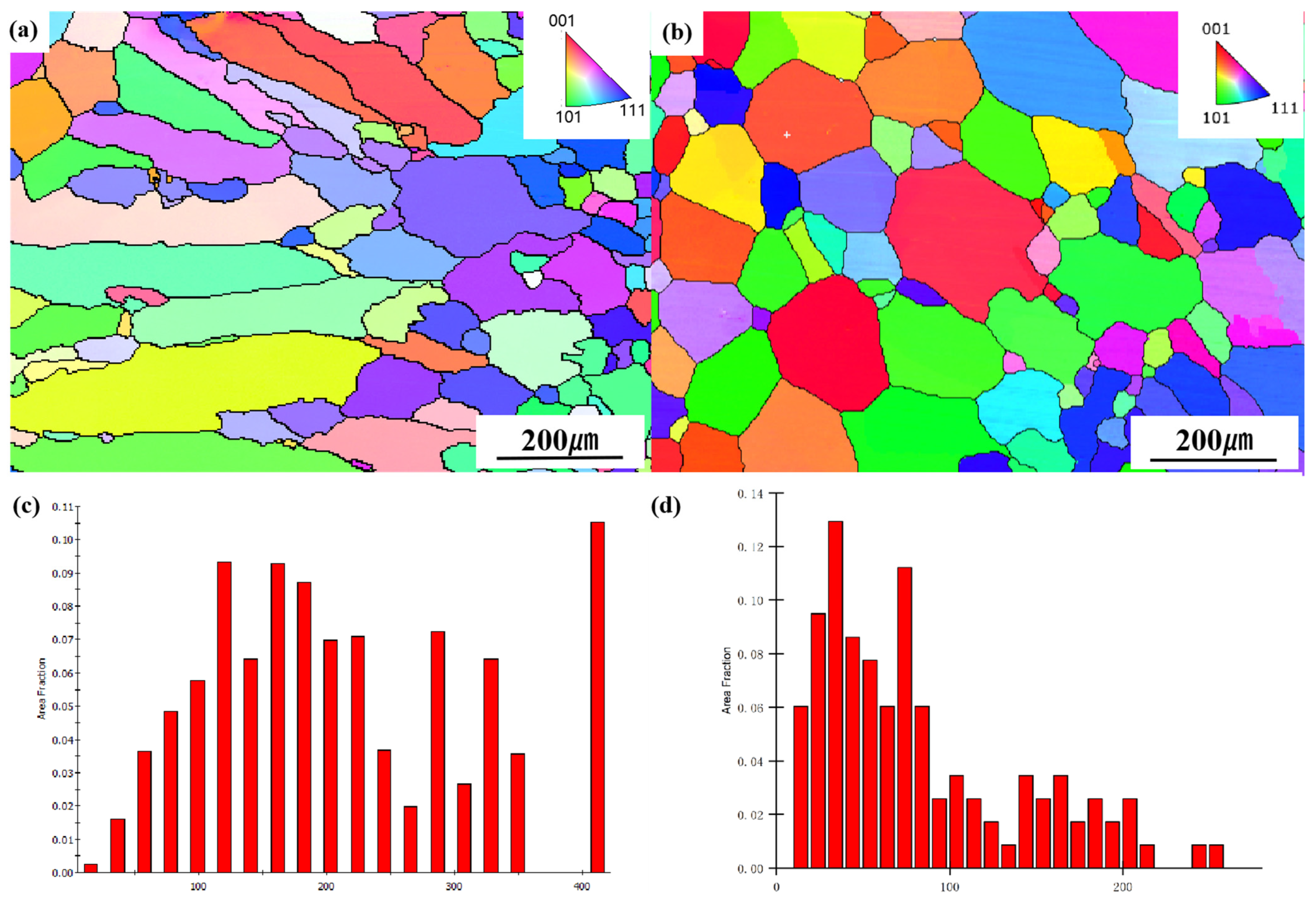


| C | Cr | Nb | Ti | Si | Mn | P | S | Ni |
|---|---|---|---|---|---|---|---|---|
| ≤0.03 | 17.5~18.5 | (3 × wt.%C + 0.3)~1.0 | 0.1~0.6 | ≤1.00 | ≤1.00 | ≤0.04 | ≤0.03 | ≤1.00 |
| Yield Strength (MPa) | Tensile Strength (MPa) | Elongation Rate (%) | HV |
|---|---|---|---|
| ≥240 | ≥370 | ≥30 | 150 |
| Sample | Yield Strength (MPa) | Tensile Strength (MPa) | Elongation Rate (%) |
|---|---|---|---|
| 110 W | 298 ± 8 | 388 ± 8 | 24.6 ± 0.9 |
| 130 W | 332 ± 9 | 436 ± 10 | 31.6 ± 1.2 |
| 140 W | 320 ± 11 | 420 ± 11 | 31.0 ± 0.9 |
| 150 W | 294 ± 8 | 394 ± 10 | 31.4 ± 0.4 |
| No Ultrasonic Input | 285 ± 10 | 375 ± 11 | 26.4 ± 1.8 |
Disclaimer/Publisher’s Note: The statements, opinions and data contained in all publications are solely those of the individual author(s) and contributor(s) and not of MDPI and/or the editor(s). MDPI and/or the editor(s) disclaim responsibility for any injury to people or property resulting from any ideas, methods, instructions or products referred to in the content. |
© 2023 by the authors. Licensee MDPI, Basel, Switzerland. This article is an open access article distributed under the terms and conditions of the Creative Commons Attribution (CC BY) license (https://creativecommons.org/licenses/by/4.0/).
Share and Cite
Zhao, X.; Chen, Y.; Zhang, W.; Liu, Y.; Zhang, Y. Study on the Microstructure and Mechanical Properties of Ultrasonic-Assisted TIG Welded 441 Ferritic Stainless Steel Joints. Metals 2023, 13, 1924. https://doi.org/10.3390/met13121924
Zhao X, Chen Y, Zhang W, Liu Y, Zhang Y. Study on the Microstructure and Mechanical Properties of Ultrasonic-Assisted TIG Welded 441 Ferritic Stainless Steel Joints. Metals. 2023; 13(12):1924. https://doi.org/10.3390/met13121924
Chicago/Turabian StyleZhao, Xiaohui, Yunhao Chen, Wenqiang Zhang, Yu Liu, and Yunhui Zhang. 2023. "Study on the Microstructure and Mechanical Properties of Ultrasonic-Assisted TIG Welded 441 Ferritic Stainless Steel Joints" Metals 13, no. 12: 1924. https://doi.org/10.3390/met13121924




